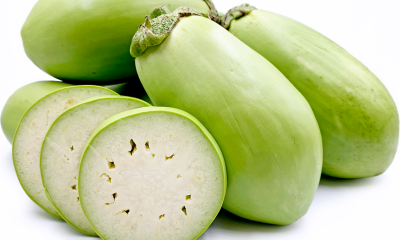Health
Benefits of apple cider vinegar gummies

Discover the benefits of apple cider vinegar gummies.
We all remember when we were kids and we had a jar of vitamin gummy that tasted like candy. One of the best ways to get younger children to take their vitamins is by camouflaging them as one of their favorite snacks: fruit snacks.
Apple Cider Vinegar (ACV) gummies may not be as palatable to younger children, but they have a lot of appeal for adults.
Recently, ACV gummies have been gaining in popularity—here’s a brief overview of what apple cider vinegar is and why it’s all the rage.
What is apple cider vinegar?
Apple cider vinegar has been a popular home remedy in cooking and medicine for centuries.
There are many mentions about the therapeutic effects of apple cider vinegar, but it is important to note that it has not been shown that it can treat or cure diseases; however, they can be used together for greater health benefits.
Some people claim that stroke can prevent and treat multiple diseases, including cancer, but there is no research to back up these claims.
Making apple cider vinegar is a bit different than making apple cider. Both are made from pressed apples, but in ACV the apples are fermented. Fermentation is the chemical breakdown using bacteria or yeast.
During the fermentation process, the sugar in apples is converted to alcohol and after adding beneficial bacteria to further fermentation, it creates acetic acid.
Acetic acid is one of the main components of vinegar and is responsible for many of the health benefits in vinegar, including apple cider vinegar.
Other types of vinegar are made by fermenting grains, while apple cider vinegar is made by fermenting apples.
ACV can mainly be purchased in two presentations, filtered and unfiltered:
The unfiltered alternative includes the “mother”, which appears cloudy when viewing the bottle. Cloudiness does not mean it has gone bad.
Rather, these are the beneficial gut proteins, enzymes, and bacteria. If you are going to use the unfiltered alternative, be sure to shake the jar first.
The filtered alternative does not have the “mother” and has undergone a filtration process and probably a pasteurization process as well.
Both types of ACV can be used in a variety of ways, such as baking, cooking, beauty products, and even household cleaning. It’s a versatile ingredient and a great kitchen staple to have on hand.
Health benefits of apple cider vinegar gummies
The health benefits are one of the main reasons ACV is so popular. Here are some of the main pathologies on which apple cider vinegar could have an effect.
1. Regulation of blood sugar level
The blood sugar level is the amount of glucose in our blood that the body can use for energy. When levels rise and fall inconsistently, this can lead to chronic disease.
Some studies have shown that taking apple cider vinegar before a high-carbohydrate meal might slow the rate at which food passes from your stomach to your intestines.
A slower rate of emptying prevents sudden ups and downs in blood sugar levels. ACV might also help improve insulin sensitivity by moving more glucose out of the bloodstream.
It has been shown that around four teaspoons a day can produce benefits. Remember to take your medications as prescribed and work with your healthcare professional if you are making any changes.
2. Weight Loss
Some report better weight control when supplementing with ACV. A common report is a feeling of fullness that causes people to eat less.
A 3-month study found that daily consumption of apple cider vinegar led to a reduction in abdominal fat and weight loss.
The best results have been seen when combined with diet and lifestyle changes.
Adding an item to your lifestyle probably won’t have a significant effect on your overall weight loss or weight management. For long-term success in weight management, consult with a registered dietitian.
3. Elimination of bacteria
Vinegar has been used for its antibacterial properties for many years, especially in cleaning agents and cooking methods such as pickling.
Vinegar, including apple cider vinegar, may help kill pathogens like bacteria, though it may not be as effective as commercial-grade cleaners.
It could also be used to preserve food, as it prevents the growth of bacteria in food to prevent it from spoiling quickly.
4. Cholesterol reduction
There have been some studies that indicate that vinegar might reduce the chance of developing heart disease. These conditions are often genetic, but dietary changes have also shown benefits.
An animal study showed that ACV intake reduced cholesterol and triglyceride levels, both of which are associated with heart health.
There are no conclusive human studies regarding these claims, so definitive conclusions cannot be drawn.
Ways to take apple cider vinegar
There are several ways to take ACV: it can be in the form of liquid, capsules, tablets, and gummies. Recently, gummies have become a popular way to take supplements, especially for those who don’t like the taste of a nutrient in other forms.
Gummies are edible, sweet, and chewy, and sometimes come in various shapes and sizes. Taking supplements in gummy form has several advantages:
Gummies are practical. If you’re on the go or in a hurry, it’s easy to take apple cider vinegar gummies with you wherever you go. They are easy to take and you won’t have to drink water or worry about how much liquid you have when you pack.
Gummies are typically preferred because they taste better than other forms of supplements. This makes them an attractive alternative. This also increases the desire to take your vitamins and leads to less forgetfulness.
Having a fun period in the day, like taking a vitamin gummy, could be nostalgic and fun. The best way to remember to do something is to have fun doing it. A flashback to the past can be an invigorating way to take your vitamins.
Something to consider when choosing supplements in the form of gummies is the sugar content. To make them taste sweet like a fruit snack, sugar sometimes needs to be added.
Some vitamin gummies may have 2 to 8 grams of sugar per serving. When the amount of added sugar is higher, this reduces the health benefits, even when combined with health-promoting foods like apple cider vinegar.
If sugar is excluded, the gummies could use artificial sweeteners or sugar alcohols, which could cause digestive problems in some people.
Because they are so delicious, they may be easier to overeat. Keep in mind what the recommended portion is and stick to it. Excess consumption, especially in children, can lead to vitamin or mineral toxicity.
Vegans and vegetarians looking to add apple cider vinegar gummies to their routine, or any other type of gummy, can take a look at the ingredient list. Many gummies are made with cornstarch, water, sugar, food coloring, and gelatin.
Gelatin is made from the bones and ligaments of animals and is not suitable for vegans or vegetarians. Instead, choose a vegan-friendly ACV gummy that uses pectin.
Ways to use apple cider vinegar
Not only can you take ACV orally as a nutritional supplement, but you can also use it at home or in cooking or baking. Here are some ideas for incorporating this must-have product into your routine.
Prepare an all-purpose cleaner by mixing 1 cup of water with a half cup of apple cider vinegar.
Do you have fruit that has been out in the open too long or a new plant in the house? You may need help catching fruit flies. Pour 1/4 cup of apple cider vinegar into a glass and add a few drops of dish detergent and they’ll be gone in no time.
Prepare a solution for fruits and vegetables that allows you to better clean your produce. Using apple cider vinegar to wash your product may help reduce bacteria like Escherichia coli and Salmonella.
Side Effects of Apple Cider Vinegar
In general, ACV is safe to consume, but it could cause side effects in some people. Due to its high degree of acidity, regular intake could damage tooth enamel.
Those who use medications such as insulin or diuretics should also check with their healthcare professional before making any changes, as ACV may have drug interactions with these medications.
If you experience nausea or vomiting after taking ACV, this could be due to heartburn. Stop use immediately and see your doctor.
Conclusions
All in all, apple cider vinegar can be very effective, both for use at home and for possibly promoting health benefits related to blood sugar, weight management, and bacteria.
If you’re thinking of taking ACV, check with your doctor before starting anything new.
Health
8 shocking health benefits of Tamari

Table of Contents
Health
10 benefits of wakame seaweed and side effects

Table of Contents
-
- 1.- Benefits of wakame seaweed for diabetes
- 2.- Benefits of wakame seaweed for weight loss
- 3.- Helps balance hormones
- 4.- Benefits of wakame seaweed for Bones
- 5.- Benefits of wakame seaweed for breast cancer
- 6.- Benefits of wakame seaweed during pregnancy
- 7.- Reduce high blood pressure
- 8.- Reduces cholesterol naturally
- 9.- Good source of iron
- 10.- Rich in Omega-3 fatty acids
- How to use and cook Wakame seaweed
- Side effects of wakame seaweed
- Discover the 10 shocking health benefits of wakame seaweed and side effects.Seaweed has long been a staple of Japan, which is one of the longest living cultures in the world. Is there a connection? In particular, the benefits of wakame seaweed are rich in various vitamins and minerals.
They provide a great nutritional boost while supporting the cardiovascular system, maintaining hormonal balance, strengthening bones, improving circulation, and promoting healthy skin.
Some research suggests that the benefits of wakame seaweed may reduce breast cancer incidence and mortality among postmenopausal women; It’s no wonder that Japanese marine farmers have been farming wakame for hundreds of years.
Additionally, like many sea vegetables, wakame seaweed adds a delicious component to a variety of foods but has recently gained popularity due to its many health benefits.
-
1.- Benefits of wakame seaweed for diabetes
An important component in the benefits of wakame seaweed is fucoxanthin, it has an antidiabetic effect.
The anti-obesity and anti-diabetic effects of fucoxanthin-rich wakame seaweed lipids were tested in a group of obese mice, this study showed that these algae can significantly suppress body weight.
Before wakame treatment, the mice showed signs of hyperglycemia, hyperinsulinemia, and hyperleptinemia, but the addition of wakame algae to the diet normalized these conditions.
The researchers concluded that wakame seaweed can prevent diabetes, related disorders, and obesity by reversing the insulin resistance that is due to a high-fat diet.
2.- Benefits of wakame seaweed for weight loss
The fucoxanthin present in wakame seaweed benefits promotes fat burning within the fat cells of animals.
Fucoxanthin is believed to fight fat in two ways: it encourages the action of a protein that causes fat oxidation, and it is found in the type of fat that surrounds the organs.
It also promotes the production of DHA in the liver, which helps lower bad or LDL cholesterol.
Fucoxanthin also reduces the weight of abdominal white adipose tissue in rats and mice, making it one of the best fat-burning foods.
3.- Helps balance hormones
The benefits of Wakame seaweed provide in addition to manganese, a little iron, and calcium, three of the minerals that help balance hormones naturally.
Manganese and calcium help improve PMS symptoms; Because manganese helps with hormonal regulation and shows antioxidant activity, wakame seaweed can also work as a natural treatment for infertility.
4.- Benefits of wakame seaweed for Bones
One hundred grams of wakame seaweed provides 15 percent of your daily value for calcium, which is essential for preventing osteopenia or osteoporosis.
Foods rich in calcium help increase bone growth and accelerate bone repair, while calcium deficiency occurs easily because we lose the mineral through the intestines, kidneys, and skin.
Osteoporosis is a common feature of aging; It involves bone loss that begins in women at the time of menopause and men at 55 years of age.
It can lead to increased rates of fractures, which is why getting enough calcium in your diet is so important.
5.- Benefits of wakame seaweed for breast cancer
There is a small body of research that suggests there is a relationship between seaweed and a lower risk of breast cancer.
In traditional Chinese medicine and Japanese folk medicine, seaweed is used to treat tumors. People who eat seaweed regularly, especially in Japan, have dramatically lower rates of breast cancer.
In 2013 the impact of the introduction of the benefits of wakame seaweed in the diet of postmenopausal women was evaluated.
15 healthy postmenopausal women were recruited for the three-month clinical trial.
Five of the women had no history of breast cancer (they served as a control group) and 10 were breast cancer survivors.
Consumption of seaweed reduced concentrations of the urokinase-type plasminogen activator receptor, a protein that is present in several physiological sites and is generally higher among postmenopausal women.
The concentration of uPAR is known to influence cell surface signaling, adhesion to calls, and growth factor communication and response in breast tissue.
Researchers believe that the ability of wakame seaweed to decrease these receptors may help explain the lower incidence of breast cancer and mortality among postmenopausal women in Japan.
There’s no question about it, science is backing up these amazing benefits of wakame seaweed, and more studies are underway to evaluate its effectiveness as a cancer treatment or preventive measure.
6.- Benefits of wakame seaweed during pregnancy
Folate or B12 is an essential vitamin present within the benefits of wakame seaweed; it is necessary to copy and synthesize DNA, produce new cells, and support nerve and immune function.
Folate is known to be one of the most critical vitamins or a vibrant healthy pregnancy.
For pregnant women, folate deficiency is especially risky because it can lead to neural tube defects such as spina bifida, anencephaly, limb malformations, and heart complications.
Because folate is needed to copy DNA and build new cells, it is vital that pregnant women consume enough folate foods, such as wakame seaweed, to decrease the risk of developmental problems.
7.- Reduce high blood pressure
Several studies have investigated whether the benefits of wakame seaweed can naturally prevent high blood pressure.
One study found that treatment with wakame seaweed significantly lowered systolic blood pressure in spontaneously hypertensive rats.
Another study in Japan admitted that the wakame diet may have beneficial effects on hypertension.
A study was carried out in 2011 and examined whether seaweed could affect blood pressure in children.
Healthy Japanese preschoolers, ages 3 to 6, measured blood pressure and pulse before and after a three-day period that involved consuming seaweed.
Blood pressure measurements, complete diet records, and parent-reported height and weight were obtained for 223 boys and 194 girls.
The researchers found that girls with the highest seaweed consumption had significantly lower systolic blood pressure readings.
The results suggest that seaweed ingestion was negatively related to diastolic blood pressure in boys and systolic blood pressure in girls, demonstrating that seaweed could have beneficial effects on blood pressure among boys.
8.- Reduces cholesterol naturally
The fucoxanthin present in most of the wakame seaweed benefits serves another function: it stimulates the liver to produce DHA, which helps reduce the amount of harmful cholesterol in the body.
Therefore, it is an excellent food for lowering cholesterol.
One study found that dry wakame seaweed powder altered the activities of enzymes involved in fatty acid metabolism in the liver in rats.
Rats that were fed diets containing powdered wakame had lower levels of triacylglycerol, suggesting that wakame seaweed is useful as food to prevent hyperlipidemia.
Hyperlipidemia means that there are too many lipids or fats in the blood, this leads to high levels of cholesterol and triglycerides, which can lead to the development of dangerous pests and blockages.
9.- Good source of iron
The iron in wakame kelp benefits increases red blood cell production and helps with the metabolic enzyme processes the body carries out to digest protein and absorb nutrients from food.
An iron deficiency is the most common nutritional deficiency in the world and is associated with developmental delay, altered behavior, decreased intellectual performance, and decreased resistance to infection.
Excessive iron supplements can cause iron overload and should be avoided, so the safest and surest way to get enough iron per day is to stick to iron-rich foods like wakame.
10.- Rich in Omega-3 fatty acids
Wakame seaweed is a rich source of omega-3 fatty acids, which is an essential fatty acid because it is not made by the human body, but it is still necessary for normal metabolism.
Omega-3 foods can be used to lower cholesterol, fight depression, reduce anxiety, reverse diabetes, reduce inflammation, relieve arthritis, and promote skin health.
They have also been shown to support weight loss, healthy pregnancy, sports recovery, and thickening of hair and nails.
Due to the excessive consumption of omega-6 fats in the Western world, we must stick to the omega-3 foods that our bodies need.
How to use and cook Wakame seaweed
You can find dry or fresh wakame seaweed; It can be stored in a refrigerator, where it is preserved with sea salt, or it can be found in a sealed package where it is dehydrated and brittle, similar to nori (the seaweed used for rolling sushi).
If you have dehydrated wakame seaweed, start by cutting it into small pieces as it will expand after rehydration.
To rehydrate wakame, soak in water for approximately 30 minutes or until smooth; It can then be added to soups, French fries, and salads. The water used to rehydrate wakame is also packed with nutrients, so it can be used as a base for the soup.
Side effects of wakame seaweed
Although wakame seaweed is a nutritious food that offers a handful of health benefits, it does contain a good amount of sodium, 872 milligrams per 1 ounce of wakame.
People with high blood pressure may want to watch their wakame intake to make sure they are not consuming too much sodium in a day, as sodium works against potassium to lower blood pressure levels.
Benefits Of Wakame Seaweed For Diabetes
However, if you don’t want to eat Wakame seaweed directly, add them to different foods. For instance, you can make rice balls with wakame seaweed or just use it to give flavour to sushi. Talking about sushi, if you are interested in eating delicious sushi, sushiro delivery can deliver fresh sushi to your doorstep.
Health
Health benefits of pumpkin flower for eyesight

Table of Contents
- Pumpkin flower properties
- All your general health benefits of pumpkin flower
- How can pumpkin blossoms protect our eyesight
- Some precautions
- Discover the Health benefits of pumpkin flower for eyesight.The pumpkin flower is a highly recommended food for the many benefits it brings due to its magnificent properties and for being an extraordinarily versatile food, since the pumpkin flowers can be prepared raw or cooked (in batter, for example) and also added to soups and salads.
Pumpkin flower properties
The main properties of this food are:
•The pumpkin flowers are an important source of vitamins A, C, B1, B2, B3 and B9.
•They are especially rich in calcium.
•They also provide various minerals: iron, calcium, phosphorus, potassium and magnesium.
•It is a food that contains hardly any saturated fat, sodium and fiber.
•It is also very low in cholesterol.
•Almost 90% of its content is water.
At the quantity level, for every 100 grams of the edible part of the pumpkin flower we find:
•95, 15 grams of water.
•Only 0.24 grams of fat.
•Calcium is counted between 39 and 47 grams.
•Smaller amounts of potassium, iron, and magnesium.
All your general health benefits of pumpkin flower
•The pumpkin flower helps to delay the symptoms of aging, since it prevents the oxidation of LDL (which is a low-density lopoprotein).
•It promotes the formation of white blood cells, which strengthens the immune system and, therefore, the effective response of the body against the attack of infectious agents.
•It favors the production of repair enzymes.
•Being rich in phosphorus and calcium, they are highly recommended for children and adolescents, since they are in full growth.
•In addition, pumpkin flowers increase the formation of repair and anticancer enzymes and may even help block the development of malignant cells.
How can pumpkin blossoms protect our eyesight
Like all foods rich in Vitamin A, pumpkin flowers help to delay and minimize the symptoms of aging in the body, and especially in the sense of sight. Hence, it can be said that this food helps prevent age-related visual pathologies:
•Cataracts .
•Diabetic retinopathy .
•Age-Related Macular Degeneration ( AMD ).
Some precautions
The pumpkin flower is a food that, as we have commented, can be eaten both raw and cooked and stands out for being very digestive. However, to consume it safely, it is advisable to take some precautions:
Buy them in specialized stores, to ensure that they are perfectly identified and that we know that their origin is totally safe.
They should be washed very well with fresh water before use.
Once they are perfectly washed, you have to drain them well, hanging them by the stem, being very careful not to spoil the petals.
It is not advisable to keep these flowers in the refrigerator for more than 24 hours, as they are very delicate. The ideal is to buy them in the right amount before consuming them.
Eating foods rich in Vitamin A , including pumpkin flowers, is one of the simplest and most natural ways to protect our eyesight. If we also lead a life where healthy habits prevail, such as exercising to the best of our ability and going to a specialist for regular check-ups and check-ups, we will greatly increase the chances of enjoying good visual health for a long time.
We hope the article on the Health benefits of pumpkin flower for eyesight has been of help.
-

 Food5 months ago
Food5 months ago10 + Benefits of carrot juice and side effects
-

 Food5 months ago
Food5 months ago8 shocking benefits of leek juice and side effects
-

 Health5 months ago
Health5 months agoBenefits of guava leaves Sensually
-

 Health5 months ago
Health5 months ago10 shocking health benefits of Canary seed milk
-

 Health5 months ago
Health5 months ago7 health benefits of cashew leaves and side effects
-

 Health5 months ago
Health5 months ago13 shocking health benefits of Thai eggplant
-

 Weight Loss5 months ago
Weight Loss5 months agoKelly Osbourne weight loss 2022
-
Weight Loss5 months ago
Chrissy Metz Weight Loss Secret (2022)












